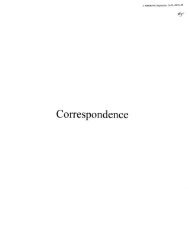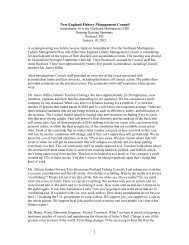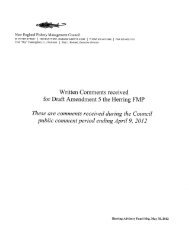Smooth Bottom Net Trawl Fishing Gear Effect on - New England ...
Smooth Bottom Net Trawl Fishing Gear Effect on - New England ...
Smooth Bottom Net Trawl Fishing Gear Effect on - New England ...
Create successful ePaper yourself
Turn your PDF publications into a flip-book with our unique Google optimized e-Paper software.
NOAA/NMFS Unallied Science Project, Cooperative Agreement NA16FL2264 December 2005<br />
<str<strong>on</strong>g>Smooth</str<strong>on</strong>g> <str<strong>on</strong>g>Bottom</str<strong>on</strong>g> <str<strong>on</strong>g>Net</str<strong>on</strong>g> <str<strong>on</strong>g>Trawl</str<strong>on</strong>g> <str<strong>on</strong>g>Fishing</str<strong>on</strong>g> <str<strong>on</strong>g>Gear</str<strong>on</strong>g> <str<strong>on</strong>g>Effect</str<strong>on</strong>g> <strong>on</strong> the Seabed:<br />
Investigati<strong>on</strong> of Temporal and Cumulative <str<strong>on</strong>g>Effect</str<strong>on</strong>g>s BKAM/CR<br />
reduced/anoxic underlying sediments. The depth of the RPD provides a measure of the<br />
degree of biologically-mediated oxygen penetrati<strong>on</strong> (i.e., aerati<strong>on</strong>) of the sediment<br />
surface. The average RPD depths of 2.3 and 2.6 cm at the trawl and c<strong>on</strong>trol stati<strong>on</strong>s,<br />
respectively, generally indicate good sediment aerati<strong>on</strong> and a moderate-to-high degree of<br />
biogenic sediment mixing (Table 3.5-1).<br />
The sandy surface sediments at the Little Tow stati<strong>on</strong>s appeared to be inhabited by a<br />
benthic community dominated by surface-dwelling, tube-building polychaetes (Stage I).<br />
The images at many of the Little Tow stati<strong>on</strong>s had numerous tubes of these organisms<br />
visible at the sediment surface (e.g., Figure 3.5-1). A small percentage of the images also<br />
showed evidence of larger-bodied, deeper-dwelling benthic organisms (Stage III)<br />
underlying the Stage I surface tubes (e.g., Figure 3.5-1, image A). This resulted in the<br />
assignment of a “Stage I <strong>on</strong> III” successi<strong>on</strong>al status to these images (Table 3.5-1). The<br />
average OSI values were +5.2 and +5.6 for the trawl and c<strong>on</strong>trol lane stati<strong>on</strong>s,<br />
respectively. These are intermediate values that reflect the dominance of the lower-order<br />
successi<strong>on</strong>al stage (i.e., Stage I) that is comm<strong>on</strong>ly found in a sandy benthic envir<strong>on</strong>ment.<br />
3.5.2 Baseline Characterizati<strong>on</strong> of the Mud Hole Area<br />
The results of the August baseline survey at the trawl and c<strong>on</strong>trol stati<strong>on</strong>s in the Mud<br />
Hole area are summarized in Table 3-2. In general, the surface sediments in the Mud<br />
Hole area were similar in appearance (i.e., color and texture) to those in the Little Tow<br />
area. These sediments c<strong>on</strong>sisted predominantly of muddy very fine sand, having a grain<br />
size major mode of either 4 to 3 phi (very fine sand) or 3 to 2 phi (fine sand; Table 3.5-2<br />
and Figure 3.5-2). Reflecting these grain size characteristics, the benthic habitat<br />
classificati<strong>on</strong> at the Mud Hole stati<strong>on</strong>s was primarily either UN.SS (unc<strong>on</strong>solidated<br />
sediment c<strong>on</strong>sisting of very fine sand mixed with silt-clay) or SA.F (uniform fine sand;<br />
Table 3.5-2).<br />
The average camera penetrati<strong>on</strong> values at the Mud Hole stati<strong>on</strong>s (6.3 and 6.9 cm) were<br />
slightly deeper than those at the Little Tow stati<strong>on</strong>s, suggesting a slightly softer texture<br />
attributed to higher apparent amounts of silt-clay at a greater percentage of the Mud Hole<br />
stati<strong>on</strong>s. The average boundary roughness values at the Mud Hole trawl and c<strong>on</strong>trol<br />
stati<strong>on</strong>s were less than 1.4 cm and similar to those at the Little Tow stati<strong>on</strong>s, again<br />
indicating that the sediment surface had relatively little microtopography. Likewise, the<br />
average RPD depths at the Mud Hole stati<strong>on</strong>s were comparable to those at the Little Tow<br />
stati<strong>on</strong>s, indicating good sediment aerati<strong>on</strong> and a moderate-to-high degree of biogenic<br />
sediment mixing.<br />
Similar to the Little Tow area, the sandy surface sediments at the Mud Hole stati<strong>on</strong>s<br />
appeared to be inhabited by a benthic community dominated by surface-dwelling, tubebuilding<br />
polychaetes (Stage I; Figure 3.5-2). A small percentage of the Mud Hole images<br />
also showed evidence of larger-bodied, deeper-dwelling benthic organisms (Stage III)<br />
underlying the Stage I surface tubes, resulting in the assignment of a “Stage I <strong>on</strong> III”<br />
successi<strong>on</strong>al status to these images (Table 3.5-2; Figure 3.5-2 image A). The average<br />
OSI values at the Mud Hole stati<strong>on</strong>s were likewise similar to those at the Little Tow area.<br />
52







